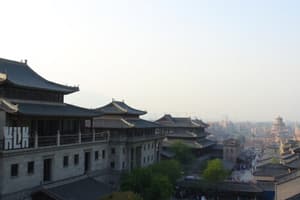Podcast
Questions and Answers
What was the perception of shopkeepers in China, Korea, and Japan?
What was the perception of shopkeepers in China, Korea, and Japan?
- They were not well perceived and faced discrimination. (correct)
- They were predominantly landowners.
- They were considered essential for trade and economy.
- They were respected for their production skills.
What role did tributes and gifts play in Chinese trade practices?
What role did tributes and gifts play in Chinese trade practices?
- They were a method to start wars with other nations.
- They were used to buy land from foreign powers.
- They established goodwill and aided in trade relations. (correct)
- They provided military supplies to neighboring countries.
Which city is highlighted for its strategic importance on the Silk Road?
Which city is highlighted for its strategic importance on the Silk Road?
- Chang'an
- Dunhuang (correct)
- Beijing
- Luoyang
What significant discovery was made in the Library Cave in Dunhuang?
What significant discovery was made in the Library Cave in Dunhuang?
What types of manuscripts were found in the Library Cave?
What types of manuscripts were found in the Library Cave?
Which of the following describes a consequence of security related to trade?
Which of the following describes a consequence of security related to trade?
What is a true statement regarding the trade practices mentioned?
What is a true statement regarding the trade practices mentioned?
What significant geographical feature did the trade route around Dunhuang navigate?
What significant geographical feature did the trade route around Dunhuang navigate?
What shape was the ideal city according to Chinese tradition?
What shape was the ideal city according to Chinese tradition?
How many gates did Luoyang have, which deviated from the traditional ideal?
How many gates did Luoyang have, which deviated from the traditional ideal?
What was the main reason for the Han dynasty to establish alliances with nomadic tribes during the 2nd century BCE?
What was the main reason for the Han dynasty to establish alliances with nomadic tribes during the 2nd century BCE?
What was the Steppe Route primarily used for?
What was the Steppe Route primarily used for?
What was considered a symbol of bad luck in relation to the layout of Luoyang?
What was considered a symbol of bad luck in relation to the layout of Luoyang?
Which commodity was primarily traded along the Steppe Route?
Which commodity was primarily traded along the Steppe Route?
How did the attractiveness of the Valley during the Silk Roads era primarily manifest?
How did the attractiveness of the Valley during the Silk Roads era primarily manifest?
What was a common misconception about merchants in the context of trade during the time of the Han dynasty?
What was a common misconception about merchants in the context of trade during the time of the Han dynasty?
Flashcards are hidden until you start studying
Study Notes
Luoyang
- Luoyang was a major city during the Han Dynasty.
- It was not a perfect square city like other cities in Chinese tradition.
- It had 14 gates.
- The Imperial Palace was in the north, which was considered bad luck.
- The city was very prosperous.
- It became the capital of the Eastern Han Dynasty in 25.
- The Cao Wei Regime took over the city in 220.
- The Western Jin Dynasty took over in 266.
Origins of Silk Road
- The Silk Road was not established by Zhang Qian in the 2nd century BC.
- The Steppe Route was in place before the Silk Road.
- The Steppe Route connected Eastern Europe with China.
- The Silk Road was not about making money.
- The Silk Road was developed by the Han Dynasty for security purposes.
- While trade flourished along the Silk Road, merchants were not highly regarded.
Sogdians and the Silk Road
- The Sogdians were very interested in the Silk Road.
- They traded goods, including silk, fabrics, and horses.
- The Sogdians participated in connecting different parts of the Silk Road.
- The Silk Road was successful because of diplomacy and gifts.
Dunhuang
- Dunhuang is a city in northwestern China.
- It is on a crossroads of two major trade routes.
- Dunhuang is an oasis on the edge of the Taklamakan Desert.
- Merhcants arriving in China from the west would encounter Dunhuang.
Mogao Caves
- The Mogao Caves were excavated in 366 AD.
- The caves were expanded by the Tang Dynasty.
- The caves were a major site for Buddhist art and literature.
- The caves were a center for trade.
The Library Cave
- The Library Cave was discovered in 1900.
- It contains more than 50,000 manuscripts.
- The manuscripts date back to the 4th to the 11th centuries.
- The manuscripts are in many languages, including Sanskrit, Tibetan, Tangut, Uyghur, Khotanese, Kuchean, Sogdian, Mongolian, Hebrew, and Chinese.
Studying That Suits You
Use AI to generate personalized quizzes and flashcards to suit your learning preferences.

